AUCTORES
Globalize your Research
Research Article | DOI: https://doi.org/10.31579/2637-8914/221
1Universidad Nacional del Centro del Perú.
2Ministerio de Salud Peru.
*Corresponding Author: Edith Rosana Huamán Guadalupe, Universidad Nacional del Centro del Perú.
Citation: Huamán Guadalupe ER, Miryam S. Camargo, Chirinos Tellez GLAC, (2024), Effect of the Implementation Project of Integral Development Centers on Child Development Indicators in Children Under Three Years Old, J. Nutrition and Food Processing, 7(7); DOI:10.31579/2637-8914/221
Copyright: © 2024, Edith Rosana Huamán Guadalupe. This is an open access article distributed under the Creative Commons Attribution License, which permits unrestricted use, distribution, and reproduction in any medium, provided the original work is properly cited.
Received: 21 March 2024 | Accepted: 26 June 2024 | Published: 16 July 2024
Keywords: chronic malnutrition, psychomotor development
Aim: Evaluate the Effect of the project to implement comprehensive development centers on child development indicators in children under three years of age in San Jeronimo, The beneficiary results of the PICED belong to the 2006-2019 longitudinal study to assess the effects of the PICED project on children under three years of age served by the PICED. The measurements were carried out according to the international standard methodology for data processing. The application was used. SpSS v27.
Results: The number of children under 3 years of age who carry out at least four early stimulation sessions per month is 5,225 boys and/or girls under 3 years of age in the systematization area. The number of children at risk of psychomotor development totals 150 minors., with deficits in their psychomotor development are 532 minors and with psychomotor delay 25 minors. The number of children with delayed psychomotor development recovered were 783 minors, the number of children at risk of development of the motor area recovered were 279 minors, the number of children at risk of development of the coordination area recovered were 279 minors, the number of children at risk of development of the personal social area recovered were 279 minors,
Conclusion:
It was verified that the size of the effect of the project on the chronic malnutrition indicator managed to reduce chronic malnutrition in the districts where the intervention was carried out.
It is stated emphatically that there is no more important moment in the life of a child (and the human being) for their development than the first three years of life, in which early interventions that seek to strengthen their bond with parents, social investments and their environment, have greater impact and leave deep marks on their personalization process and socialization, than at any other time in your life.
Among the reasons for priority attention and basis for human and social developmentiiiof childhood would be: a)Scientific advances that support the importance of child care from pregnancy, especially up to 3 years of age; b) Care for children as the most solid basis for building democracy and citizenship; and, c) Child care influences local and national development.
In this sense, UNICEF alsoiiiproposes the following as basic rights of every boy and girl, especially children from 0 to 3 years old: a) Protection against physical danger; b) Adequate nutrition and health care; c) An appropriate vaccination; d) An adult with whom to establish emotional ties; d) An adult who understands her signals and knows how to respond to them; e) Objects to look at, touch, listen, smell, taste; f) Occasions to explore the world around them; g) Appropriate stimulation of language, as a tool of communication and encounter with others and their culture; h) Support to acquire new motor, linguistic and mental skills based on their abilities and possibilities; i) The possibility of obtaining a certain degree of independence; j) Help to self-contain or learn to control behavior; k) Occasions to learn to take care of themselves; l) Daily occasions to play with certain objects that promote their development.
There are also other complementary rights such as: a) Build your person in an environment that stimulates and facilitates your development; b) Have adults who take care of him with sufficiently good support and physical and mental support; c) Respect for their individuality and their way of being and being in the world here and now; d) Be recognized as a subject of action and transformation; e) That their own abilities to learn are recognized and respected.
In this sense, UNICEF and UNESCOiv, the two United Nations organizations most characterized by their interest and educational attention in childhood, point out that in Latin America and the Caribbean there is greater awareness about the importance of the first years in human development, although the concept of initial education It refers to different age groups in different countries and in which the ministries or institutions where government responsibilities fall are different. However, boys and girls from 0 to 3 years old are primarily served through non-formal modalities, while formal pre-school education serves children from 4 to 6 years old.
Most countries do not have a reliable data or information system. Data on care coverage of non- formal programs are practically non-existent. There is also an absence of studies on the analysis of demand and the adequacy of supply.
Childhood in Peru is an issue that demands the intervention of public and private bodies, the confluence of different disciplines with approaches that make it possible to understand the special complexity of the problem and the proposal of creative and lasting solutions. There is a pressing need to rethink the way in which children are being approached, worked on and supported in the country, in which reflection, understanding, convergence and inter-institutional cooperation, supported by political will, is essential, so that The child is recognized as a developing person and the necessary measures are taken so that every girl and boy in the country can receive support as an active subject. In addition to the preparation of professionals and auxiliary and promoter personnel who can carry out this complex work with ethical, theoretical, philosophical and scientific supports, which allows rethinking and developing strategies relevant to the needs and competencies of the boys and girls of the country and the regions.
In Peru, the main State policy instruments regarding early childhood are the Millennium Goals, the National Agreement, the National Food Security Strategy, the National Plan of Action for Children and Adolescents, the National GROW Strategy, the National Plan to Overcome Poverty, the National Plan for Education for All, the National Family Support Plan.
For example, the National Agreement, in its Sixteenth Policy, indicates“Strengthening the Family, Protection and Promotion of Children, Adolescents and Youth.”DS Nº027-2007-PCM mentions:“6.2: Develop programs aimed at reducing infant mortality, preventing chronic diseases and improving the nutrition of minors. 6.3 Adopt measures to eradicate child labor and support the promotion of responsible parenthood”. And Law No. 29289 - Public Sector Budget Law 2009, prioritizes theMaternal Neonatal Health; the Articulated Nutritional program; Learning achievements at the end of the III Cycle and Access to identity.
For its part, the Regional Government of Junín outlined as its first policy:The fight against poverty, supporting the population's efforts to develop their capabilities within a framework of equal opportunities, pointing out howStrategic Objective: Reduce Chronic Malnutrition in children under 5 years of age to 6% by 2010. It currently has the motto“Girls and boys First in Junín”, in whose framework as Social Investment Projects, implements theProject “Early Stimulation Centers for Boys and Girls Under 3 Years of Age – PICED", with the Objectives of a) Promote the comprehensive development of boys and girls under 03 years of age and pregnant mothers; b) Reduce the psychomotor development deficit; c) Reduce abuse and family violence.
Inprenatal stimulation, Obstetricians develop stimulation sessions with pregnant women, feeding and nutrition sessions, together with prenatal control, recognizing the intrauterine child as a sensitive and intelligent being with memory and learning capacity. In early stimulation: Nurses and Early Education Teachers provide early stimulation to girls and boys from 0 to 3 years old, using techniques to promote learning, taking into account the age of the child, the development of their skills and what they want to achieve; with individualized attention, in stimulation rooms from 0 to 1 year, 1-2 years, 2-3 years.
Study Design
A quasi-experimental study was carried out with baseline and final measurement between 2006 and 2019 with children under three years of age.
Population And Sample
The number of children under 3 years of age who carry out at least four early stimulation sessions per month is 5,225 boys and/or girls under 3 years of age in the area of systematization.
Measurements
Inprenatal stimulation, Obstetricians develop stimulation sessions with pregnant women, feeding and nutrition sessions, together with prenatal control, recognizing the intrauterine child as a sensitive and intelligent being with memory and learning capacity. In early stimulation: Nurses and Early Education Teachers provide early stimulation to girls and boys from 0 to 3 years old, using techniques to promote learning, taking into account the age of the child, the development of their skills and what they want to achieve; with individualized attention, in stimulation rooms from 0 to 1 year, 1-2 years, 2-3 years.
Ethical Aspect
For the project, after initial contacts with educational and health authorities, official permission was requested from those who direct the PICED participating in the study. The authorization of the parents and the consent of each student was obtained; The identity of the participants was kept confidential in the data analysis phase. It is important to emphasize that for the application of the survey and the taking of the corresponding anthropometric measurements of the children, the parents were informed about the study, its objectives, indicating that there is no risk against them or their child by participating. of the study, and the information provided will be confidential. Once the mother or father voluntarily agreed to participate, I signed the respective informed consent. So the study was framed within the codes of medical ethics and health research of the Declaration of Helsinki.
Analysis of Data
The results were entered into an Excel database by double digitation, after the control they were exported to the SPSS v 25 program for data analysis.
The number of children under 3 years of age who carry out at least four early stimulation sessions per month is 5,225 boys and/or girls under 3 years of age in the systematization area.
The number of children at risk of psychomotor development totals 150 minors, with deficits in their development
psychomotor are 532 minors and 25 minors have psychomotor retardation.
The number of children with delayed psychomotor development recovered was 783 minors.
The number of children at risk of motor area development recovered was 279 minors.
The number of children at risk of development of the coordination area recovered was 279 minors. The number of children at risk of development of the personal-social area recovered was 279 minors.
According to Table No. 1, during 2019, 5,225 children under 3 years of age are served, in the scope of systematization of the project. Of the total number of children, 532 minors presented deficits in their psychomotor development; 150 minors were at risk in their psychomotor development; and 25 minors showed signs of delay in their psychomotor development.
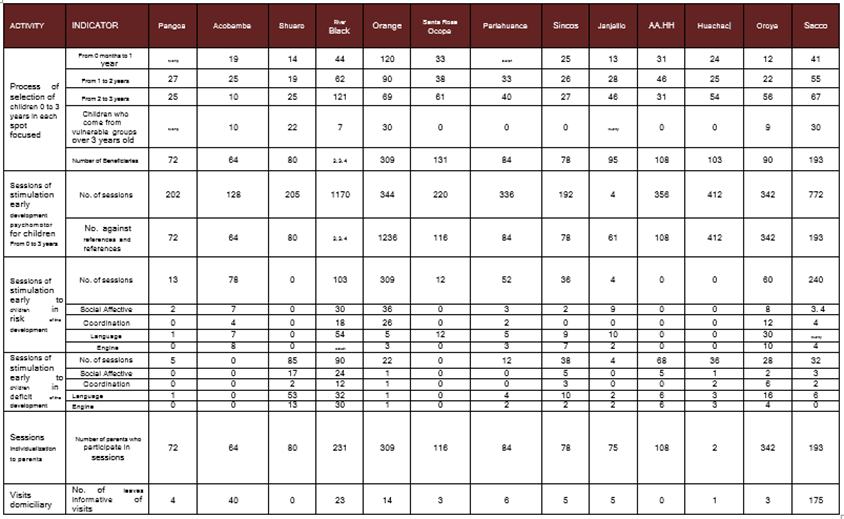
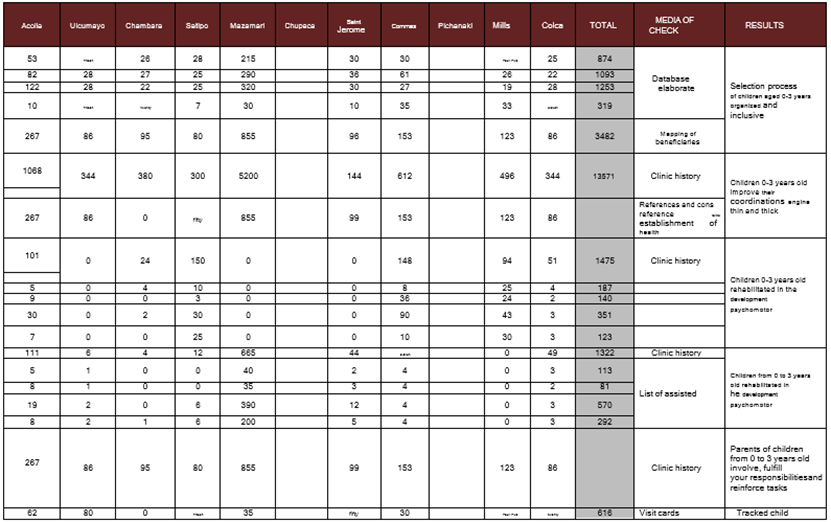
Table N° 1: Early Development Stimulation, December, 2019


SOURCE: GRJ – GRD – SGDS – PICED Project Coordination, September 2019.
Table Nº 2: Participants in nutrition sessions, December, 2019
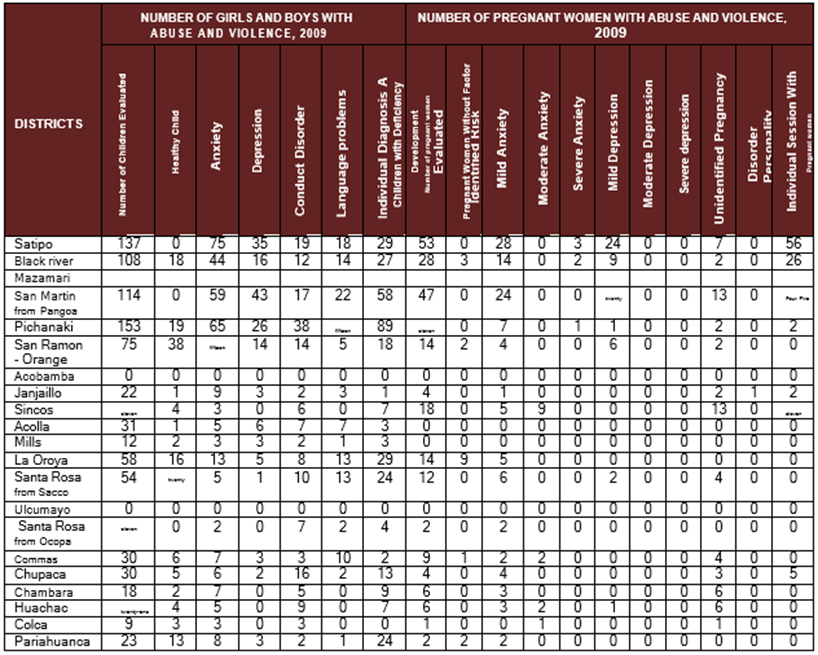
SOURCE: GRJ – GRD – SGDS – PICED Project Coordination, September 2019.
Table Nº 3: Number of girls and boys with abuse and violence and number of pregnant women with abuse and violence

SOURCE: GRJ – GRD – SGDS – PICED Project Coordination, September 2019.
Table N° 4: Number of children at risk of psychomotor development, by age, 2019
According to Table No. 1, during 2019, 5,225 children under 3 years of age are served, in the scope of systematization of the project. Of the total number of children, 532 minors presented deficits in their psychomotor development; 150 minors were at risk in their psychomotor development; and 25 minors showed signs of delay in their psychomotor development.

Table N° 5: Number of children with deficits, referred and recovered in the Psychomotor Development Area, By age, 2019

SOURCE: GRJ – GRD – SGDS – PICED Project Coordination, September 2019.
Table N° 6: Number of children with deficits, referred and recovered in the Psychomotor Development Area, By age, 2019
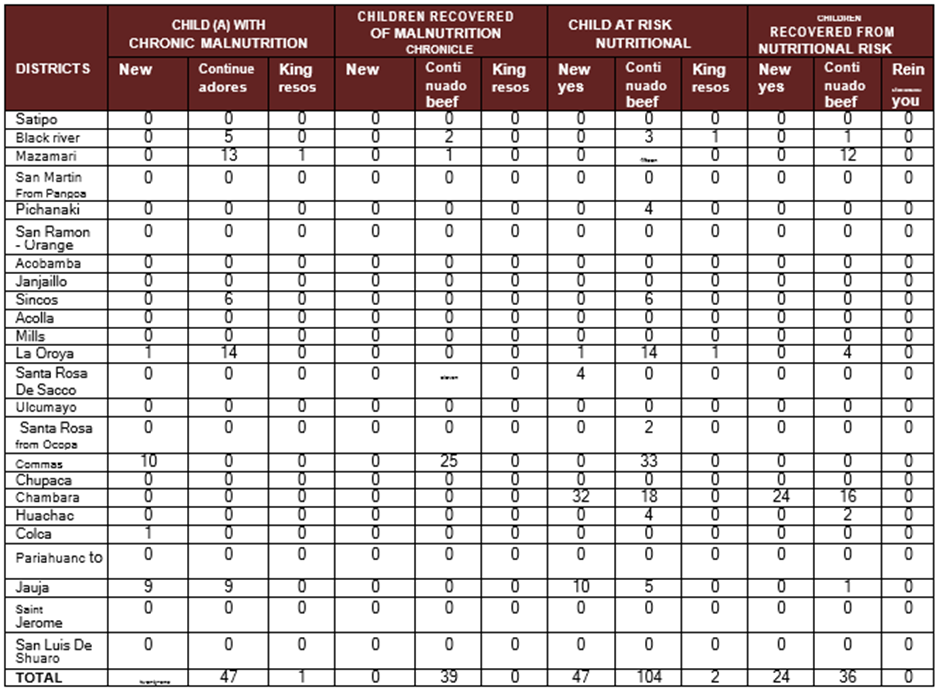
SOURCE: GRJ – GRD – SGDS – PICED Project Coordination, September 2019.
Table Nº 7: Nutrition of boys and girls under 3 years of age, 2019
SOURCE: GRJ – GRD – SGDS – PICED Project Coordination, September 2019.
According to the previous table, within the scope of the PICED project, during 2019, there were a total of 69 children under 3 years of age with chronic malnutrition, while 39 children have recovered. Likewise, there were 153 minors with nutritional risk, while 60 from some nutritional risk have recovered.
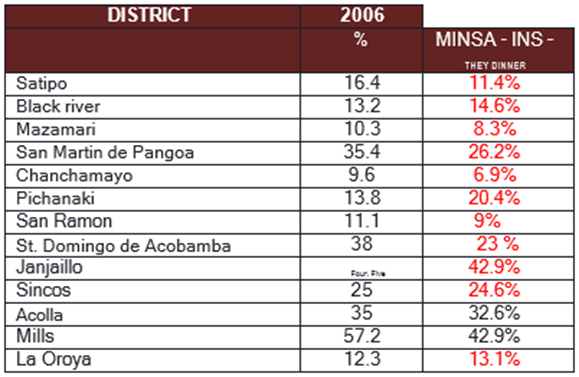
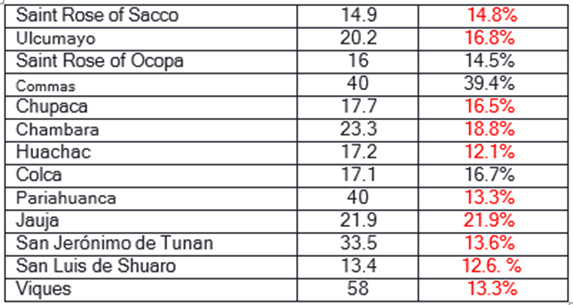
Table N° 8: Percentage of children under 3 years of age, with chronic malnutrition, According to districts, 2006 – 2019
SOURCES: 1) DIRESA-JUNIN, Office of Statistics and Informatics – Operational Report / HIS. Sep. 2019.
2) Estimated population by specific ages, five-year groups, according to DISA, DIRESA, Peru 2019, projected to June 30.
3) MINSA – INS – CENAN: JUNIN SIEN 2019.
According to the previous table, chronic malnutrition in children under three years of age in the area of intervention of the PICED project has worsened in most districts between 2006 and 2019, except for slight reductions such as in Chanchamayo (from 9.6 to 7.3%).), San Ramón (from 9 to 5.7%), Santa Rosa de Ocopa (from 16 to 15.1%) and San Luis de Shuaro (from 13.4 to 12%). The district that presents a drastic reduction is Molinos, which fell from 57.2% in 2006 to 26.2% in 2019.
In the other districts, chronic malnutrition has clearly worsened, with the most serious cases being San Martin de Pangoa (69.4%), Comas (45.6%), Sincos (42.4%), La Oroya (39.6%), San Jerónimo de Tunan (38.9%), Santo Domingo de Acobamba (37.3%), Janjaillo (36.6), Río Negro (34.8%), Ulcumayo (31.3%), Acolla (30.7%).
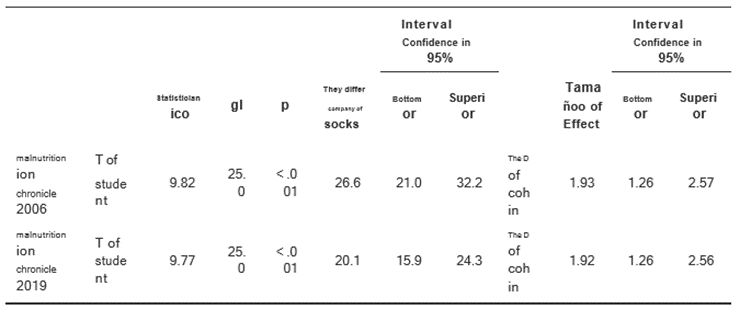
Note. Hₐ μ ≠ 0
Table 9: Effect of the project to implement comprehensive development centers on child development indicators in children under three years of age.
It was verified that the size of the effect of the project on the chronic malnutrition indicator managed to reduce chronic malnutrition in the districts where the intervention was carried out.
Evaluate the effect of the project to implement comprehensive development centers on child development indicators in children under three years of age in San Jeronimo
The children under three years old evaluated presented, 532 minors presented deficits in their development psychomotor; 150 minors were at risk in their psychomotor development; and 25 minors showed signs of delay in their psychomotor development.
In total there were 69 children under 3 years of age with chronic malnutrition, while 39 children have recovered. Likewise, there were 153 minors with nutritional risk, while 60 from some nutritional risk have recovered.
Coordinate joint actions, from the management level to the operational level, with the other projects (social and economic) implemented by the regional government, so that the results are more auspicious. For example, reducing chronic malnutrition involves implementing productive and economic actions that complement the actions of the PICED project. That is, its reduction depends on the results obtained in an articulated manner, since if the PICED intervenes in the early stimulation gap through its various components, it must be complemented with productive and economic strategies that complement the changes in the practice of early stimulation. It is not enough to change attitudes, behaviors or attitudes, it is crucial to change the socioeconomic reality in each district, in order to achieve the sustainability of the project based on the empowerment of local development actors.
Design a new baseline with the approach called “Baseline Study”, based on the logical framework methodology and management for results.
Improve the monitoring and evaluation system, based on the results of the baseline study of the PICED project.
Improve the project's information system, both physical and virtual, that allows quick access to its activities.